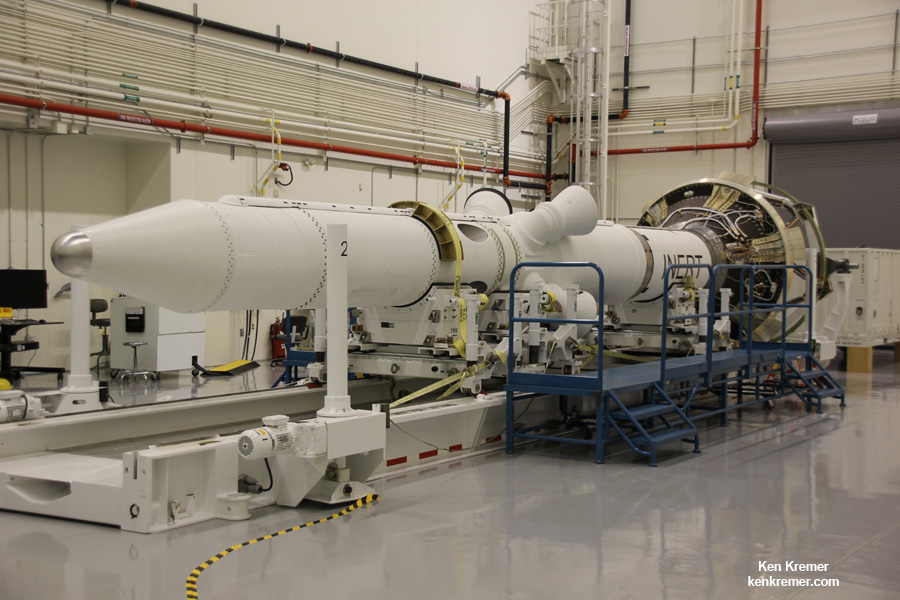
CAPE CANAVERAL AIR FORCE STATION, FL — Piece by piece, fabrication of all the major hardware elements for NASA’s inaugural unmanned Orion test flight, dubbed EFT-1, are coming together at Cape Canaveral and the Kennedy Space Center.
Orion is a state-of-the-art spacecraft and NASA’s next step in manned deep space exploration aimed at sending American astronauts back to the Moon and then beyond on voyages to Asteroids and Mars over the coming decades, if funding continues.
The main elements of the Orion stack includes the crew module (CM), service module (SM), and the launch abort system (LAS), as well as the Delta IV Heavy Booster.
During a recent visit to KSC and the Cape, this author inspected all the main Orion spacecraft and Delta rocket hardware currently on site for an assessment of the current status and projected launch date.
As of today, two of the three first stage Delta IV core boosters manufactured by United Launch Alliance (ULA) in Decatur, Ala., have arrived by barge at the Cape.
They were revealed to the media, including this author, in mid-March inside the Horizontal Integration Facility at Launch Complex 37 on Cape Canaveral Air Force Station (CCAFS).
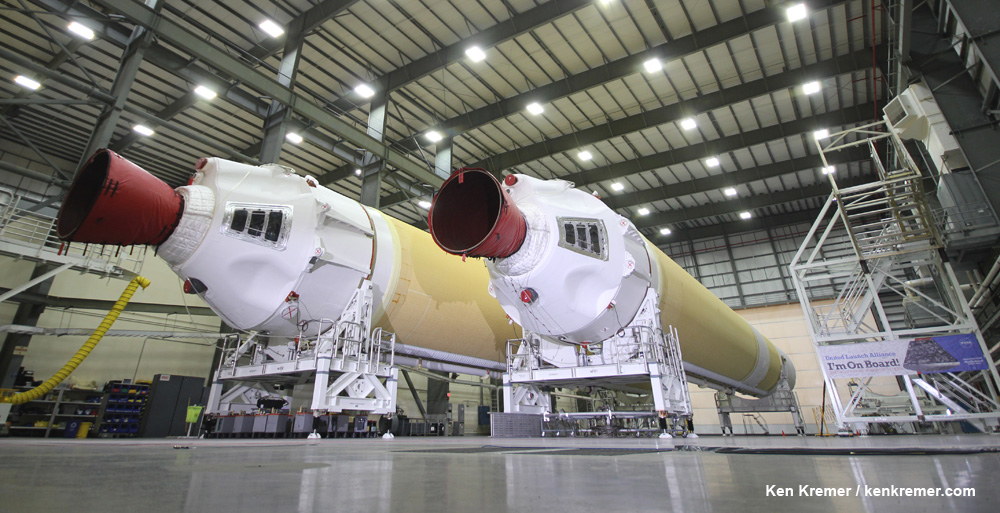
Each core is powered by a liquid-fueled RS-68 engine, providing a nominal thrust of some 663,000 pounds.
The final port side booster and the Centaur upper stage are due to be shipped by ULA to Cape Canaveral in April, a ULA spokesperson confirmed.
The triple-barreled Delta IV Heavy booster is now the mightiest rocket in America’s arsenal, with some two million pounds of thrust, following the forced retirement of the space shuttle program.
The Delta IV booster will deliver Orion to high orbit, about 3600 miles above Earth, on a two-orbit, four-hour flight lofting the pathfinding spacecraft to an orbital altitude some 15 times higher than the International Space Station (ISS). That’s farther out than any human spacecraft has ventured beyond Earth in four decades.
“This mission is a stepping stone on NASA’s journey to Mars,” said NASA Associate Administrator Robert Lightfoot during the booster unveiling at the Cape. “The EFT-1 mission is so important to NASA. We will test the capsule with a reentry velocity of about 85% of what’s expected by [astronauts] returning from Mars. We will test the heat shield, the separation of the fairing and exercise over 50% of the eventual software and electronic systems inside the Orion spacecraft. We will also test the recovery systems coming back into the Pacific Ocean.”
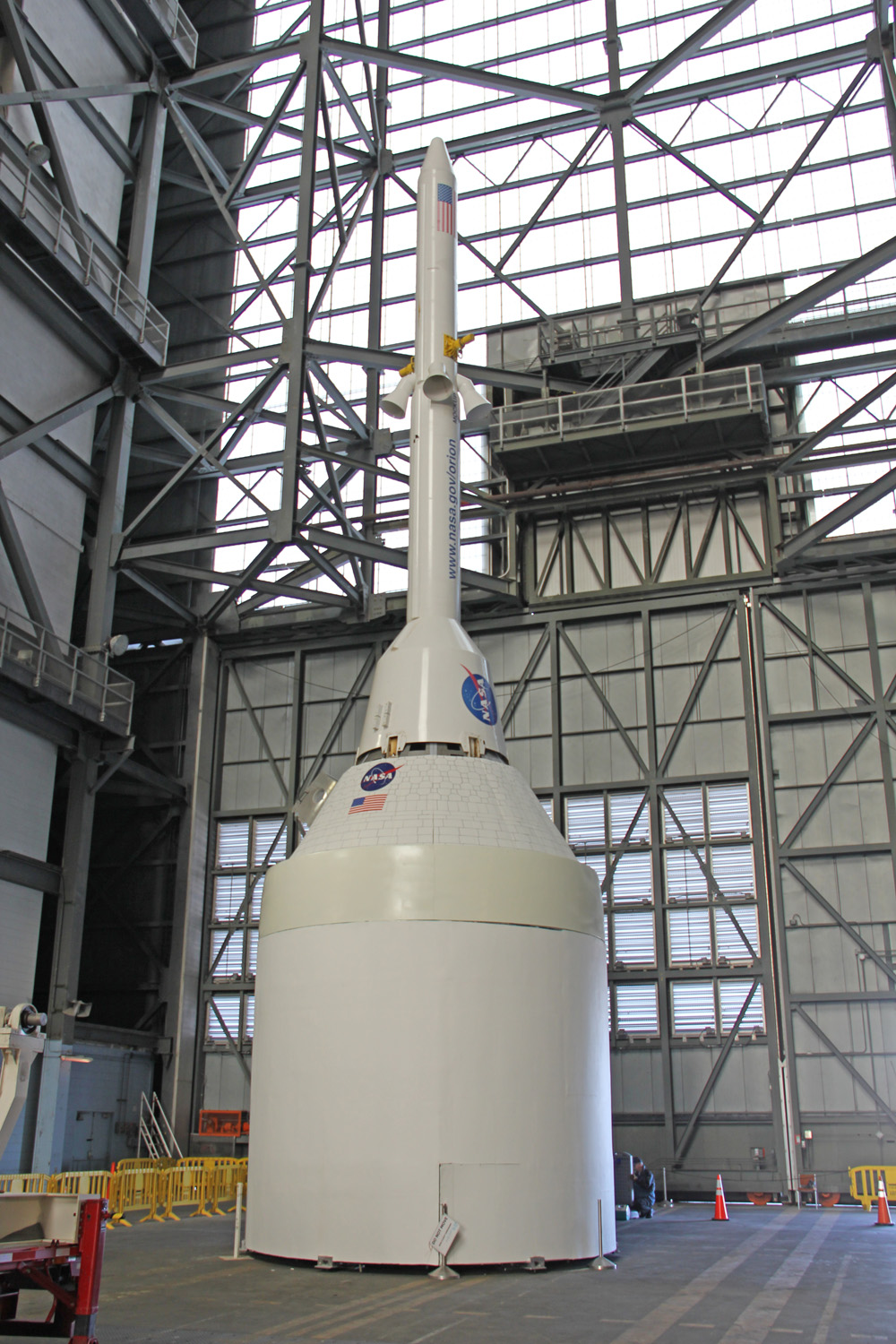
Blastoff of the Orion EFT-1 flight was recently postponed from the planned September/October window to early December 2014 to make way for a newly declassified and critical national security surveillance payload for the U.S. Air Force.
Orion will swap launch slots with the covert GSSAP satellites, which were unveiled during a February 2014 speech by General William Shelton, commander of the U.S. Air Force Space Command.
Despite the launch postponement, Lockheed Martin technicians are pressing forward with assembly activities around the clock in order to meet the original September launch, should developments warrant another switcheroo.
“Our plan is to have the Orion spacecraft ready because we want to get EFT-1 out so we can start getting the hardware in for Exploration Mission-1 (EM-1) and start processing for that vehicle that will launch on the Space Launch System (SLS) rocket in 2017,” said Bob Cabana, director of NASA’s Kennedy Space Center and former shuttle commander. “They will get the vehicle ready to roll out for the EFT-1 mission and be mounted on top of the Delta IV Heavy.”
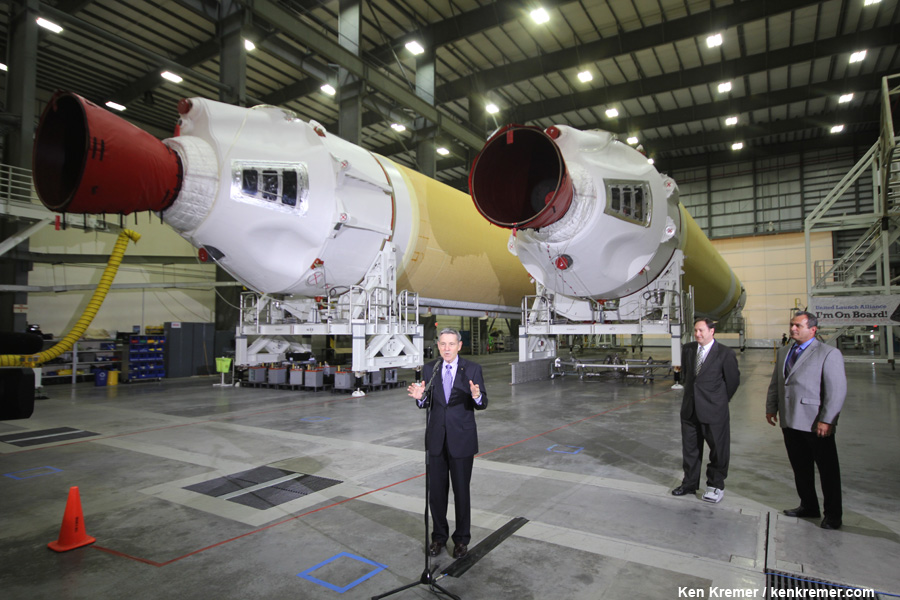
“Orion will be ready to go on time, as soon as we get our opportunity to launch that vehicle on its first flight test and that is pretty darn amazing,” Cabana stated.
Despite lasting only a few hours, the mission will fly high enough to position the vehicle for plunging back into Earth’s atmosphere and a Pacific Ocean splashdown to test the crew module, its heat shield, and parachutes at deep-space reentry speeds of 20,000 mph.
Orion will endure temperatures exceeding 4,000 degrees Fahrenheit, approximating those of the Apollo Moon landing missions that ended four decades ago.
The EFT-1 mission will provide engineers with critical data about Orion’s heat shield, flight systems, and capabilities to validate designs of the spacecraft, inform design decisions, validate existing computer models, and guide new approaches to space systems development. All these measurements will aid in reducing the risks and costs of subsequent Orion flights before it begins carrying humans to new destinations in the Solar System.
The crew module is now in the final stages of construction by prime contractor Lockheed Martin.
CM completion is due later this spring, Lockheed Martin managers told me during a visit to the spacecraft inside a specially renovated high bay in the Operations and Checkout Building (O&C) at KSC.
“We are working 24 hours a day, 7 days a week,” said Schneider, Orion Project manager for Lockheed Martin at KSC. “We are moving fast!”
Assembly of the Launch Abort System (LAS) was completed in December 2013 at KSC. In the event of a launch emergency, the LAS pulls the crew module away from the rocket in a split second to save astronauts lives.
The individual components were joined together in the Launch Abort System Facility (LASF), formerly the Canister Rotation Facility during the shuttle era.
The service module was completed in January 2014. It provides in-space power, propulsion capability, attitude control, thermal control, water, and air for the astronauts.
However, for the EFT-1 flight, the SM is not fully outfitted. It is a structural representation simulating the exact size and mass.
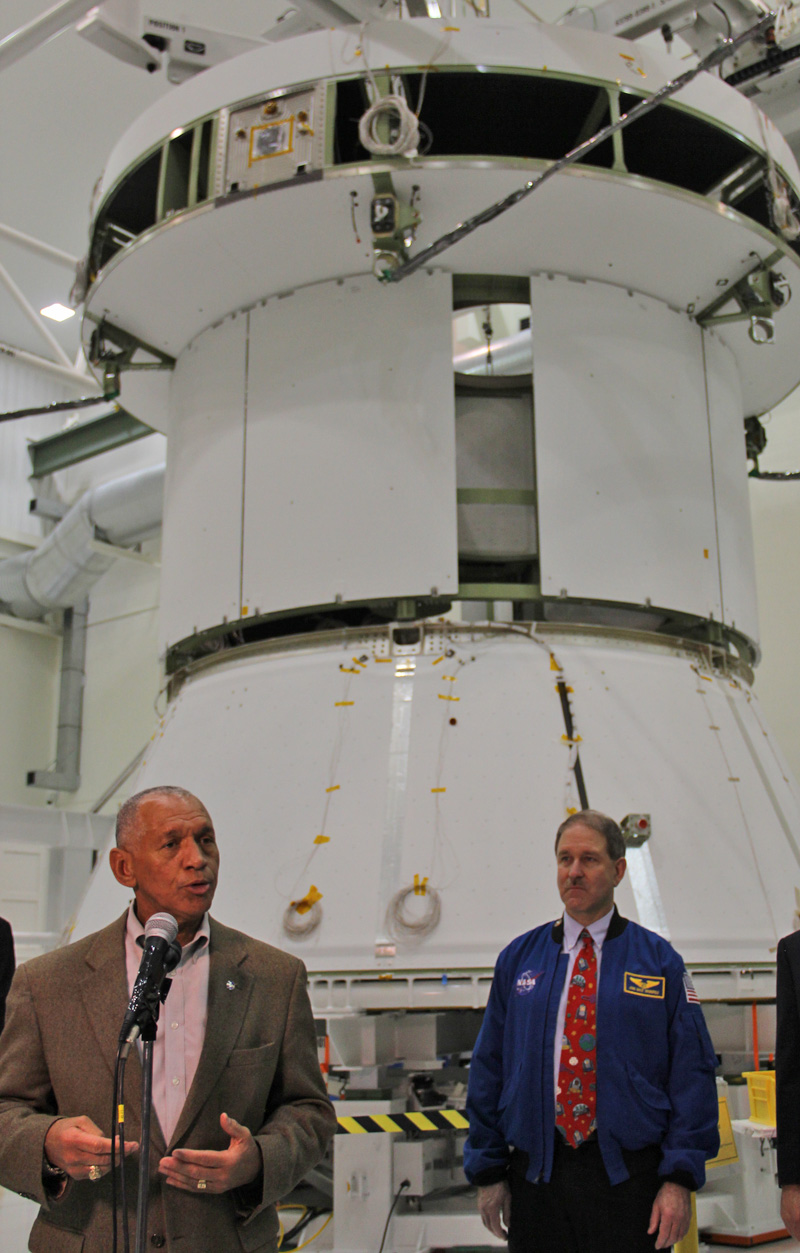
The crew module will be mounted atop, similar to NASA’s Apollo Moon landing architecture.
One significant change from Apollo is that Orion is equipped with a trio of massive fairings that encase the SM and support half the weight of the crew module and the launch abort system during launch and ascent. The purpose is to improve performance by saving weight from the service module, thus maximizing the vehicles size and capability in space.
All three fairings are jettisoned at an altitude of 100 miles up when they are no longer need to support the stack.
The European Space Agency (ESA) will manufacture the SM for the second Orion flight, EM-1, in 2017.
“We are making steady progress towards the launch,” said NASA Administrator Charles Bolden at a prior KSC media briefing, back dropped by the Orion service module inside the O&C facility.
“It’s very exciting because it signals we are almost there getting back to deep space and going much more distant than where we are operating in low Earth orbit at the ISS. And I’m very excited for the young people who will have an opportunity to fly Orion,” Bolden stated in the O&C.
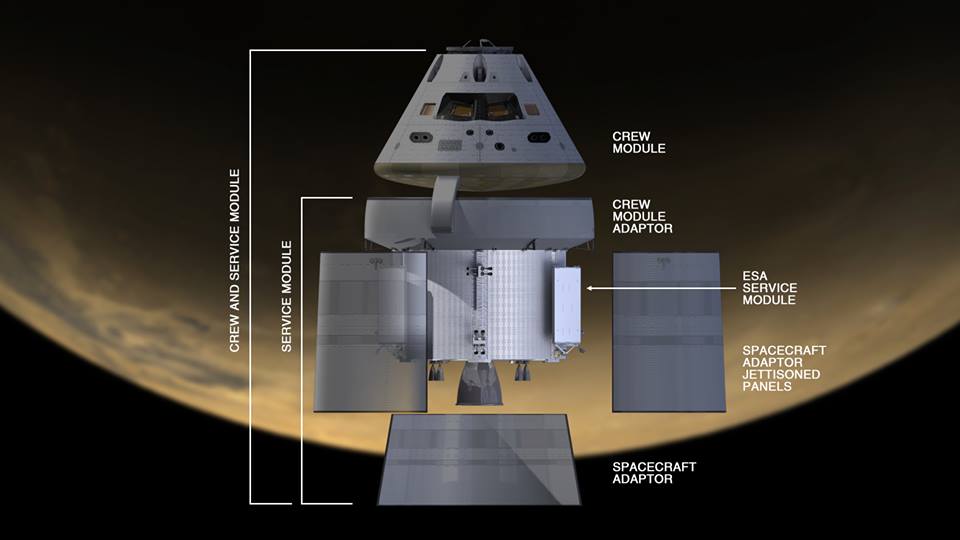
Learn more at Ken’s upcoming presentations at the NEAF astro/space convention, N.Y., on April 12/13 and at Washington Crossing State Park, N.J., on April 6.
Missions » SLS » EFT-1 »



In light of Administrator Bolden’s recent testimony before Congress that if there were any problems with access to the International Space Station because of the situation in the Ukraine, he would recommend the cancellation of Orion/SLS, it would be a very good time to re-visit HR. 3625 which would prevent the NASA Administrator from cancelling Orion/SLS, and would direct funding set aside for termination liability for Orion/SLS be used to further that program. Maybe we should cancel funding for Commercial Space and use the money to re-create the Ares-1 program to get our astronauts to the ISS? (I just had to throw that out there to set the Newspace disciples howling.)
Hey Karol,
I honestly don’t know if the lead NASA appropriators, Senators Shelby and Mikulski and Rep. Wolf, take Bolden’s statement seriously enough to even take notice of what he says. The level of distrust by appropriators, as evidenced in the last omnibus funding bill’s report, is very large.
Suffice it to say, should Russia play the ISS card and prevent U.S. astronauts from visiting the ISS, I suspect that Congressional appropriators would make their views clear to Bolden the cost to his and Phil McAlister’s pet projects should Orion or SLS be delayed.
With any means possible, we must get away from needing Russian Soyuz vehicles to get Americans into space. Come on America, what has happened to you. If we had continued with Apollo, we would probably already have a Lunar base in place. Now we are like fledglings trying to relearn to fly. Both commercial crew and NASA along with Orion, should push our boundaries toward distant space targets. Quit dragging our feet and retake the lead!
Amen, Dennis. We must look like chumps to the rest of the world where a once proud and mighty space program captured the imagination of modern civilization. Now we are hitchhikers but hopefully Orion will get us back on the space leadership path. One can only imagine where we might have been if we continued the Apollo program as you suggest. It was the lack of leadership that put us in our current pathetic position. But we can recover and do it quickly!